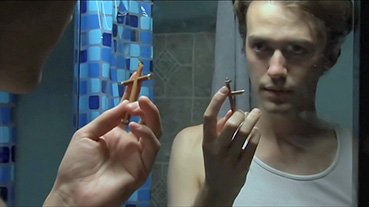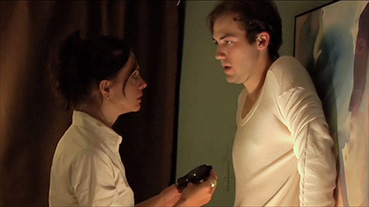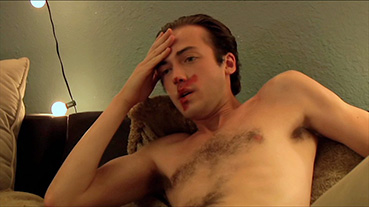|
What is it, exactly, that gives the vampire movie is continuing appeal? In nine years' time the genre will officially be a century old, at least in its film form, and the rules of engagement have not changed a lot in that time. Vampires are required to drink human blood for sustenance, will fade to dust or catch fire if exposed to sunlight, and prey on the vulnerable in the shadows of night. The early film vampires were from aristocratic stock, symbols of a class divide in which the rich fed off the poor (oh how times have changed), their shift in social status coinciding with the rise of the serial killer as a figure of real world fear, which brought a once distant threat to the house next door. With the arrival of AIDS, the syphilitic subtext of the early literary vampires was brought to the fore, and vampirism became a metaphor for the dangers sexual promiscuity. It's been a fun and often fascinating ride, one that for me culminated in 1977 with George Romero's Martin, a brilliant revisionist indie work that acknowledged the rules of the genre, ground them in reality, and then turned them on their head.
The problem for the genre as it stands today is that it's become increasingly hard to present vampires as a viable threat. With the Romanian accented aristocratic vampire of Dracula long since consigned to the coffin of comical cliché, the genre has become a playground for high-school teen vampires and their superficial angst about relationships and self-image. Nowadays, I only have to hear the word 'vampire' in reference to a movie to be able to paint an often depressingly accurate picture of how the protagonists will look and how the drama will play out. It's thus a bit of a thrill when those expectations are usurped, which is exactly what happens with Scott Leberecht's bewitching debut feature, Midnight Son.

Eschewing the current trend for pace and action-driven genre tales and their self-confident, feral or shape-shifting creatures, Midnight Son focuses exclusively on reclusive 24-year-old security guard Jacob as he undergoes a gradual metamorphosis from human to vampire, a process he is understandably both confused and alarmed by. Leberecht's first smart move is to bypass that often obligatory initial infectious bite; as the film begins, the seeds for Jacob's transformation are already growing inside him and for all he or we know may have been there since birth. He's long been a prisoner of his sensitivity to daylight, hence his decision to work nights and cover the windows of his basement flat with pictures that he paints of a sunset he will probably never see. In the very first scene, he experiences his first taste of a longing that is soon to consume him in his dizzying reaction to the sight of a bloodied plaster on the neck of the firm's janitor (a philosophical sage played by cult actor Tracey Walter), which according to his doctor is likely the result of malnourishment-triggered anaemia. A chance meeting with cigarette seller and lost soul Mary opens the door to a possible romance, albeit one his worsening condition looks set to derail.
Action movie junkies will probably be shifting in their seats from an early stage, but for the more patient among us there's something refreshing about the film's refusal to kick off with a bang and its favouring of mood and character detail over incident and pace. Nothing is overstated here, including the performances, which engage not through sassy dialogue but their low-key naturalism and easy likeability. This is particularly true of lead players Zak Kilberg and Maya Parish, impressively low-key as Jacob and Mary, but extends to even the supporting roles, including a pair of nicely pitched turns from Jo D. Jonz and Arlen Escarpeta as blood-dealing hospital orderly Marcus and his gun-toting brother Russell, who sidestep the usual wannabe gangsta clichés by keeping it real – no pun intended.
In common with all indie vampire movies worth their salt (and there haven't been that many of late), the film takes for granted that its audience knows the genre rules well enough to understand what's happening to Jacob without the need for expositional dialogue. I thus couldn't help feel a small pang of disappointment when, upon seeing the damage that sunlight has inflicted on Jacob's skin, Mary suggests that he is "just like a vampire," though the overriding tone of suggestive retraint is immediately re-established by Jacob's almost imperceptible nod of agreement. It also gives rise to a neatly handled scene in which Jacob watches Fright Night and curiously checks himself in the bathroom mirror for elongated canines and crucifix burns.

With the genre's famed addiction metaphor by now literalised to an almost surrealistic degree, the film instead develops into a haunting study of loneliness and social isolation. Confined to his basement flat by day and night work that starves him of human contact, Jacob is effectively handicapped by his condition, his attempts to seduce Mary repeatedly disrupted by symptoms of vampirism that are usually portrayed as signs of evolving aggression. In so effectively personalising the experience of Jacob's transformation, Leberecht strips the vampire myth of its glamour and mystique in much the same way Romero did with Martin. Jacob's condition is not supernatural but medical, and his confusion and suffering registers because most of us have been through exactly the same thing in one form or another, whether it be an inexplicable illness (try undiagnosed Compila Bacta if you want the real world thrill for yourself) or the mental and physical upheaval that comes with puberty. Even the more traditionally positive effects of the condition elude him, with brief signs that he has developed superhuman strength quickly revealed to be nothing more than frustration-fuelled anger.
That it all starts to go bad for Jacob is par for the genre course, as the investigation of the death of a local girl bring the police to his door and his craving for blood prompts desperate action, all of which is handled with the same eye for sensation-free realism and inventive detail as the preceding human drama. Leberecht even kicks against the genre norm with the enticing suggestion that for all its many problems, vampirism might also be solid foundation for a loving, meaningful and long-lasting relationship, a concept vividly captured in the gorgeously blood-soaked final shot. It's an ambiguous and strangely satisfying conclusion to an uncommonly smart, quietly captivating and impressively performed alternative to the glossy, effects-laden teen angst tales that seem to have been holding the genre hostage of late.
Midnight Son was shot on HD on the prosumer Panasonic HVX-200 camcorder and does have a low budget digital look at times, albeit one that suits the chosen approach rather well. Detail is very good when the lighting allows (cinematographer Lyn Moncrief has coped well with the budget and format restrictions, and according to the commentary was often a one-man team working with just two China Ball lights, and many night exteriors were shot using available light) and the contrast is pleasing within the restrictions imposed by the format itself. Colours are rarely bright and the range unsurprisingly narrows when the light levels are lower, although according to Moncrief the warm colour tones of Jacob's apartment interior were deliberately colour timed to appear that way. What does surprise is the level of banding and the sometimes visible compression artefacts on a few of the plainer surfaces, even in some of the more brightly lit shots. Whether this is an issue with the transfer or a by-product or shooting in low light is uncertain. The HVX-200 does have a rep for its image quality, but in his interview in the extras, Moncrief reveals that the digital noise that results from pushing the camera's gain was acknowledged as a sometimes necessary evil and incorporated into the film's aesthetic.

The Dolby 5.1 surround track is an appropriately subtle affair, with distinct frontal separation and only a trace of rear speaker activity. The clarity and range are very good throughout, particularly on composer Kays Alatrakchi's moodily unsettling minimalist score.
The Dolby 2.0 stereo track is of comparable quality, but with the usual wider spread of dialogue across the main speakers.
Audio commentary with director Scott Leberecht and stars Zak Kilberg, Maya Parish and Jo D. Jonz
Some mutual back-slapping, a few too many instances of "I love this..." and use of the word "awesome" aside, this is a busy and often revealing commentary peppered with interesting stories about the shoot, the performers, and the trials of shooting on a minimal budget. Leberecht does the lion's share of the talking, explaining how various actors were recruited, pointing out where shots in the same secene were filmed almost a year apart, and even surprising his companions with the revelation that some of the most convincing blood flow was CGI. The fact that these effects were created by students at the San Francisco Academy of Art is an intimidating indication of where the starting point is now for a career in this profession.
Interviews
Scott Leberecht (17:44)
Writer-director Leberecht provides some useful background to the production, including how he first came up with the idea (this is more interesting than you might think), working with the actors, devising the look of the film, shooting a feature with a minimal crew, how the CG effects ended up being done by the San Francisco Academy of Art students, and a whole lot more. Pleasingly, there is little crossover with the commentary.
Zak Kilberg (4:38)
Affable leading man Kilberg reveals what drew him to the project and how he physically prepared to play Jacob, and talks about working with director Leberecht shooting at night, and his views on the finished film.
Maya Parish (4:56)
Actress Maya Parish covers similar ground to Kilberg – how she got involved in the production, how she prepared for the role of Mandy (another interesting one), working with the director – and how she came to be one of the film's executive producers.
Jo D. Jonz (4:58)
Jonz also talks about how he came to the project and prepared for his role as Marcus, and enthuses about the performances and how well written his character was.
Lyn Moncrief (8:02)
Cinematographer Lyn Moncrief discusses the look of the film, the use of existing light, how the low budget affected his approach, and enthuses about shooting on HD.
Deleted Scenes (1:55)
Three (or is it two?) brief deleted scenes that do not add significantly to story but are still of interest.
UK Theatrical Trailer (2:27)
A neatly cut trailer that gives a little too much away to be watched just before the main feature.
There are also 4 Music Tracks – one presumes by score composer Kays Alatrakchi – that play out to a background of stills from the film.
Every time I think that the vampire movie has nothing new to show us, a film comes along to restore my faith in a genre I once doted on. Midnight Son impresses for a whole range of sometimes unexpected reasons, a subtle, intelligent and convincingly played examination of the experience of transformation from human to vampire, one that casts off the genre's supernatural trappings and grounds it in reality, which for my money makes it the best vampire movie since Let the Right One In. Taking account of the small, budget-induced restrictions imposed by the source material, Monster Pictures have delivered a solid DVD here, with a decent transfer and some worthwhile extras. Recommended.
|